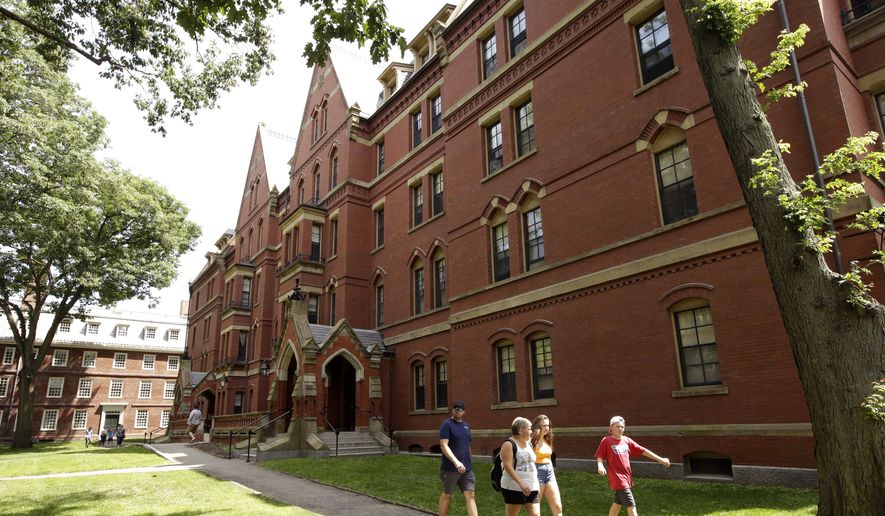OPINION:
As long as Harvard practices affirmative action, applicants seriously seeking admission should submit DNA tests to move their applications down to the JV league. Admissions officers could distinguish those among a competitive pool of over 61,000 by drops of blood, rather than by what the applicants have accomplished during their young lives.
To give its admissions practices a semblance of empiricism, Harvard scores applicants in three categories: Academics, extracurriculars, and character. Those with the highest scores earn admission. Yet, an applicant’s race is more than “a factor of a factor of a factor” of a student’s application. Rather, it is the lens with which Harvard’s admissions officers view each part of a student’s application.
The Department of Justice discovered that Harvard uses “one-pagers” to closely track the racial composition of its incoming class. To balance the spreadsheet with the “correct” racial composition, Harvard admissions officers systematically downgrade the character ratings of Asian applicants who have the highest academics and extracurricular ratings without having ever spoken to the student or inviting an alumnus to do so. On the other hand, Black students, who on average have the lowest extracurricular and academic ratings, are awarded the highest average character ratings.
The Supreme Court reasoned in Grutter v. Bollinger that such disparate treatment is permissible so long as it is for the educational benefits of diversity. However, Harvard could not persuasively articulate the alleged educational benefits of diversity beyond the mere platitude that diversity produces more rich conversations. Racial separatism shatters admissions officers’ diversity goals the moment incoming students join race-centered student organizations at the freshman orientation activities fair. Students remain self-isolated right up until their segregated graduation ceremony. If affirmative action is actually about racial balancing, then Harvard’s campus experience doesn’t even try to hide it.
At least the classroom is one of the few places on campus that is integrated. Though, as Harvard’s classrooms grow ideologically more cohesive, melanin does not replace the function of neurons. Harvard admits people who look different but who think the same.
Nor does diversity admissions expand access to science education. Admitting underqualified students to science programs mismatches students, meaning they are not competitive with their peers and drop out of STEM majors at disproportionate rates. Even though more Black and Hispanic students enter college hoping to become engineers than their white or Asian counterparts, affirmative action-induced mismatch produces fewer doctors and engineers. Qualifications matter. Students perform better at school and subsequently in life where they are academically competitive.
Harvard President Larry Bacow argues that race-centered admission is done for “the promise of a better future.” District Court Judge Burroughs gave a glimpse at Harvard’s dystopian future in defense of the university’s admissions practices: Asians “likely over-emphasize grades and test scores and undervalue other less quantifiable qualities and characteristics that are valued by Harvard and important to the admissions process.” Elite universities that graduate a generation of judges, politicians, and executives empowered to use racial stereotypes in their own decisions “makes us stronger” according to Mr. Bacow.
We are regressing back to a world where the color of one’s skin determines his personal qualities. No matter how gifted or unique an applicant is, an admissions officer who never meets him seals his fate based on his answer to the race question on his application. Just like Harvard’s “Jew Problem” in the 1920s and 1930s, history is repeating itself.
That same history tells us that even if the Supreme Court makes the morally just decision to end affirmative action this term, we must remain vigilant. After explicit quotas were criticized, Harvard cleverly changed its admissions policies to hide the exclusion of Jews and maintain its desired racial balance. Now, for example, its elimination of standardized testing admissions requirements in the name of equity after Students for Fair Admissions sued hides that its incoming classes of Hispanic and Black students regularly have standardized test scores that are on average a standard deviation below those of white and Asian applicants who were rejected.
One way or another, DNA tests will be gone. Either the Supreme Court will prohibit their use, and if the Court doesn’t, then Harvard will say that they are too expensive, and too burdensome for people of color to obtain. When that happens, applicants should just submit their pictures instead.
• Anthony Pericolo is a current Harvard Law Student and a civil rights fellow at the Center for Equal Opportunity.




Please read our comment policy before commenting.